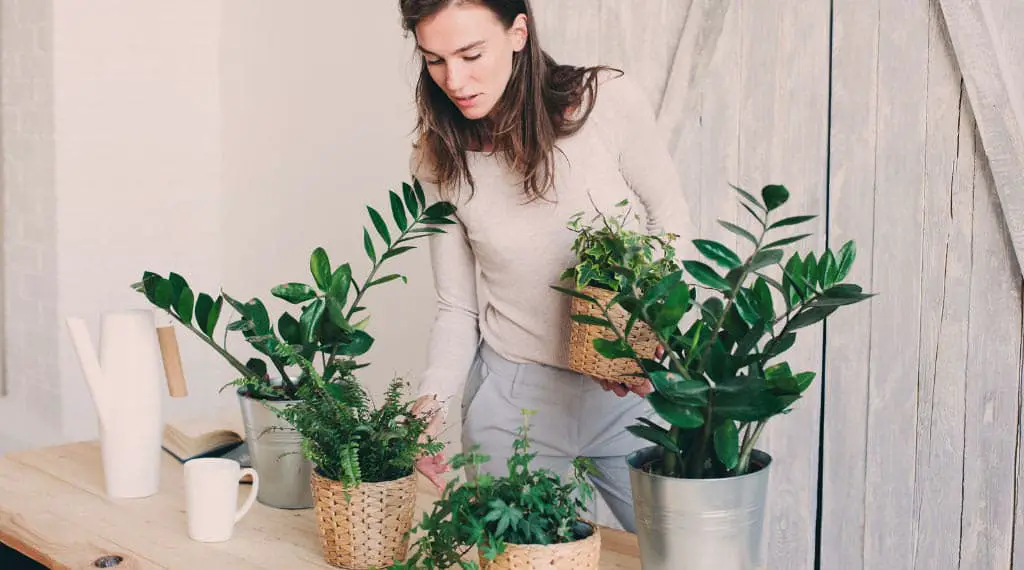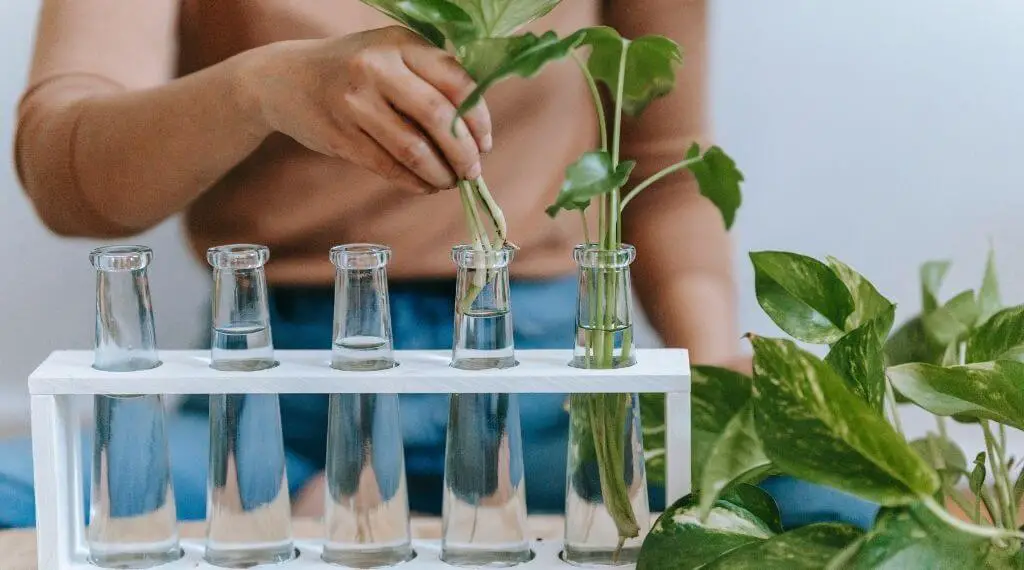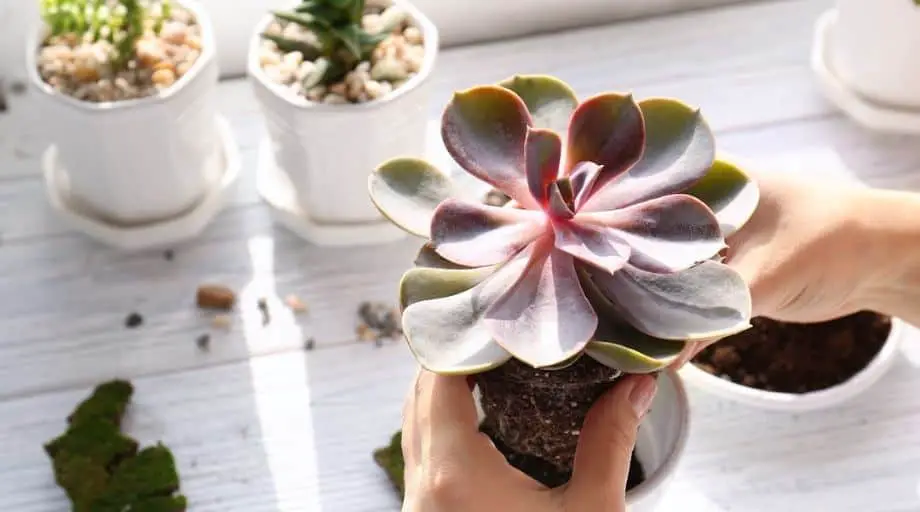Last Updated on October 5, 2021 by Plantiful Interiors
When can I put my indoor plants outside?
Moving your houseplants outside helps increase their exposure to much-needed sunlight, rain, and fresh air; solid elements that will help your plants strengthen and grow. In addition to this, rainwater will wash away any accumulated dust on their stems and leaves.
However, the question of “when can I move houseplants outside?” is not one with a clearly-defined answer. Putting your plants outside too soon may result in them dying from shock, and putting the wrong types of plants outdoors may cause them damage.
In this article, we will explore the times, temperatures, and methods for moving your houseplants outside and back inside again, and also look at some houseplants that are best left indoors year round.
This site features affiliate content. As an affiliate partner of various brands, we earn commissions on qualifying purchases, at no extra cost to you. Please read our disclaimer for more information.
At What Temperature Is It Safe To Move Houseplants Outdoors?
For the most part, it is safe to move your houseplants outdoors in regular temperatures above 55 degrees Fahrenheit. However, we recommend waiting to move your plants outdoors until temperatures are consistently between 60 – 70 degrees Fahrenheit.
That said, there are two things that you also need to consider before moving your houseplants outdoors; the season (including hardiness zones) and temperature ranges.
Ideally, you should keep your plants indoors during winter months and start moving them outside in the spring and summer (between April/May and September), first placing them outside two to four weeks after the last spring freeze. For most climates, the right season to move your indoor plants outside is the springtime.
However, you might want to be aware of what climate you are in and what really is best for your plants.
Check your plant hardiness zone to get a sense of the range of average annual extreme minimum temperatures in your area. This is based on information from the United States Department of Agriculture (USDA), but other countries have similarly styled maps.
Each hardiness zone number represents the lowest average annual temperature in a given area. For example, New York City, with its lowest annual average temperatures at 0 to 5 degrees Farenheit, is in Zone 7a. In contrast, Los Angeles, California with its lowest average temperatures ranging from 30 to 35 degrees Fahrenheit, is located in Zone 10a.
These numbers represent the kind of extremes your plants would have to face if they were left outside year-round. Though not indicative of the ideal time to place your houseplants outside each year, these numbers can help you identify what “zone” your houseplants are from — and therefore best suited to — and can even help when you purchase the ideal houseplants for your local outdoors conditions.
It is also good to know date range of the last spring freeze (also known as the last frost date). This is the date range in which you can expect the last freeze of winter to occur. Check the National Centers For Environmental Information and The Old Farmer’s Almanac for times of the last spring freeze of winter (and the first freeze of the coming winter).
In terms of temperature ranges, tender plants are killed in light freezes (29 to 32 degrees Fahrenheit) and this would likely include most houseplants. Colder temperatures (28 degrees Faherenheit and below) would cause heavy damage in even the hardiest of plants.
For your purposes, you will want to keep your plants outside in much higher temperatures. Since most houseplants originate from tropical environments you will want to keep them outside at temperatures between 60 and 70 degrees Fahrenheit.
Temperatures below 55 degrees Fahrenheit cause plant cells to freeze and can block nutrients and water from flowing properly. Extreme high temperatures (above 85 degrees), depending on the plant, can cause it to wither.
How To Move Houseplants Outdoors Without Killing Them
In order to move houseplants outdoors, you must get them acclimated to higher degrees of sunlight and other outdoor conditions.
To do this, put your plant in a position inside your home where it can receive more sunlight daily, near a south or west window, for example, as spring approaches.
Try not to overwhelm the plant with sunlight but do give it a little more each day. The same approach goes for watering your plant as the days get longer. Water your plant daily a little in the early morning or early evening, adding a bit more water each time.
Try not to overdo it, too much water will rot the roots. If the soil an inch or two below the surface is a little moist, you are good. If it is otherwise dry, your plant might need more water.
As winter is a particularly dry time, you might want to consider using a humidifier inside to help your plants adjust to moist outdoor conditions. Most houseplants will thrive in humidity levels of 50 percent indoors, but at any rate the idea is to get humidity levels close to what your plants will experience once outside.
Prune any dead leaves or stems off the plant, you won’t want any insects or bacteria eating these once outside. Also, make sure your plant is in a pot with adequate drainage holes (in case it rains).
Step1: Start moving your plant(s) outdoors by first placing it in an area with partial shade (perhaps next to a wall to prevent it from blowing over) during the day once daytime temperatures are consistently above 60-65 degrees Fahrenheit. When night comes and temperatures drop, retrieve your plant and put it in a temperate place inside.
When moving your plants outside do not place them in direct sun (even if your plant was in direct sun indoors). The light outside is much stronger than inside can can damage your plant. Your plant will need time to adjust.
Step 2: After a few days, you can start exposing your plant to increased sunlight by moving it out of the partially shaded area. As mentioned, you don’t want to expose your plant to direct sunlight immediately as this can be very damaging to your plant’s leaves. Gradually increase the amount of sun exposure over the next few days. Continue to bring it indoors at night if the temperatures are dropping below 60F.
Step3: After doing this for about one or two weeks to a month (depending on outdoor temperatures), you should be able to keep your plant outdoors at all hours and in full sunlight – just keep an eye on your plant’s leaves, if you notice burning move your plant back to a partially shaded area. You will also need to monitor the moisture level of your plant as it may require more frequent watering – we’ll go over some plant care tips next.
Caring For Houseplants Outdoors
Water: Sunlight during the warmer months will dry out your plant’s soil sooner than if the plant were inside. This means you will need to water your plants more regularly. Try to water your plants in the early morning or early evening when the sun’s rays aren’t as strong. If you drip water on the leaves wipe it off to prevent leaf burn. Test the soil if you are not sure how much you need to water.
Fertilizer: Apply fertilizer to your plants on a regular basis. Adding these essential plant vitamins (either in dry or liquid form) should be done before or during the time plants begin active growth. Get started early, we recommend starting 6-8 weeks before the last spring freeze and keep it up consistently.
Pests: Look out for pests like snails, slugs, mites, gnats, mealybugs, or aphids. Use plant-friendly bug sprays or natural remedies to keep pests away. If you think you have fungus gnats, here’s 5 proven techniques that will get rid of fungus gnats and prevent them from coming back.
Temperature: Keep an eye out on your local forecast for days of extreme heat or inclement weather. Use common sense and bring your houseplants to a covered area or inside if a large storm or heatwave is coming.
u003cstrongu003eIs rainwater good for houseplants?u003c/strongu003e
Yes. Rainwater contains more nitrates and oxygen than tapwater, making it beneficial to plants. It also has the potential to remove water-repelling hard water minerals like calcium and magnesium from the plant’s soil.
Which Plants Should Never Be Moved Outside?
Although all plants require sunlight in some manner, there are some indoor plants that should never be moved outside. This has to do with the fragility of some plants (like those whose tropical leaves or flowers do not hold up well in even the warmest of days in higher latitudes) and the fact that some plants are best suited to low-light conditions.
Some plants will have leaves that burn in direct sunlight, while others will simply need the stability of indoor conditions to grow. Plants of this nature include:
- Peace Lilly (Spathiphyllum)
- African violets (Streptocarpus sect. Saintpaulia)
- Moth orchids (Phalaenopsis)
- Parlor Palm (Chamaedorea elegans)
- Dumb canes (Dieffenbachia)
- Prayer Plants (Calathea)
- Song of India/Dragon Tree (Dracaena)
- Baby Rubber Plant (Peperomia obtusifolia)
- Devil’s Ivy (Epipremnum aureum)
- Rex begonias (Begonia rex)
Though some of these plants can handle some outdoor conditions, they are generally best left out of direct sunlight and kept indoors.
Preparing To Bring Your Houseplants Back Indoors
As the season starts to shift and temperatures begin falling, you’ll want to start acclimatizing your plants for indoor conditions again. Be aware of the average autumn temperatures of your area. Remember, you will want to bring your plants inside at temperatures lower than 60 degrees Farenheit.
Before bringing your plants in, make sure you check them for pests. If you can, wash your plants down with some warm water and treat them with neem oil. Prune your plant as necessary to fit in an indoor area, but only moderately.
To begin acclimating your plant to indoor conditions start by taking your plant in at night, putting it back outside in the morning. Repeat for several days to a few weeks, and finally keep it inside for good.
Make sure your plant gets enough sunlight once completely inside. With enough sunlight, your plant will still thrive over the winter and into the next season.
Summary
Check the hardiness of your plants to determine if they are suitable for outdoor conditions. Begin moving your indoor plants outside in the Spring with temperatures are above 60F, bringing them in at night if temperatures dip. Expose your plants to outdoor sunlight gradually as it is much stronger since it is not filtered through a window. Once temperatures remain above 60F you can leave your plants outdoors day and night, just keep an eye on the forecast and bring it indoors if a heavy storm or heatwave is expected.
Remember, your plants will need to be watered more regularly when outdoors as temperatures climb. Use a soil test kit to monitor the ph level and to know how much water your plant’s soil is holding below the surface. Before bringing plants back indoors check for pests, wash down the leaves and treat with neem oil.



